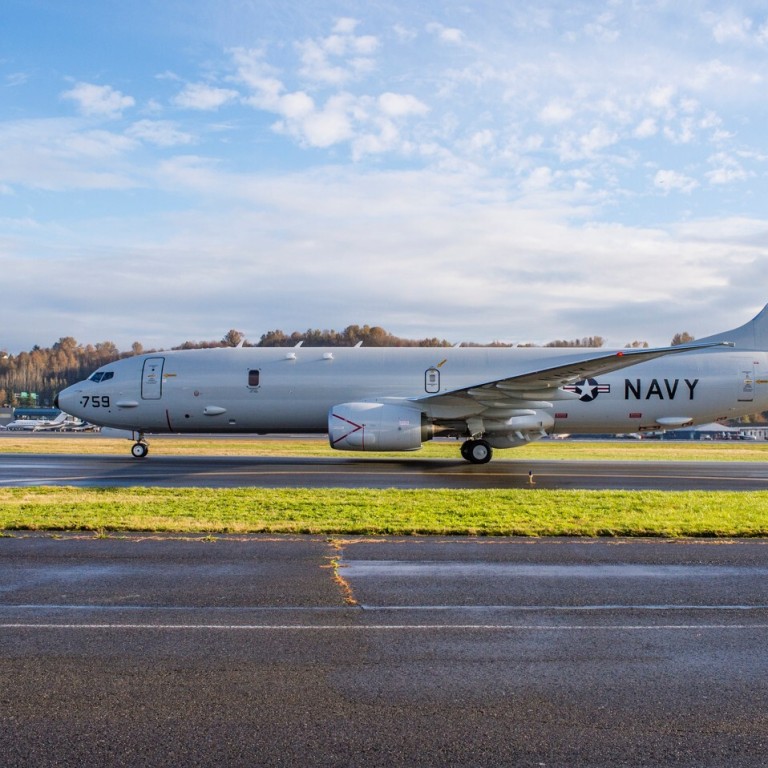
US warplane approaches Shanghai as tensions remain high amid consulate closures
- Anti-submarine aircraft came within 100km of the city – one of the closest passes in recent years – according to a university think tank
- US aircraft have been regularly approaching the Chinese coast
US warplanes have again approached the Chinese mainland, including one that came less than 100km away from Shanghai, as tensions between the two countries continue to rise with the tit-for-tat closures of consulates.
A P-8A anti-submarine plane and an EP-3E reconnaissance plane entered the Taiwan Strait, flying near the coast of Zhejiang and Fujian on Sunday, according to the South China Sea Strategic Situation Probing Initiative, a Peking University think tank.
It first tweeted about the operation on Sunday morning, later adding that the reconnaissance plane was flying back “after approaching Fujian” and “the southern part of the Taiwan Strait”.
The think tank tweeted again at night, saying the US Navy P-8A was operating near Shanghai, with the USS Rafael Peralta, a guided missile destroyer, following a similar route, asking “might be a joint operation?”.
According to a chart from the think tank, the P-8A came within 76.5km (47.5 miles) of Shanghai, the closest any US planes have come to mainland China in recent years, while the other plane came within 106km of Fujian’s southern coast.
China complains US ‘forced entry’ into Houston consulate after diplomats leave over spying claims
It was the 12th day in a row that US military planes have approached the mainland coast.
On Monday the institute tweeted that “it seems” a US air force RC-135W – another reconnaissance plane – had entered Taiwan’s airspace and asked if anyone could confirm it. The Taiwanese defence ministry declined to comment on the claims.
But in the late afternoon, the institute tweeted again, saying a EP-3E was conducting close-in reconnaissance of Guangdong less than 100km from the coast.
The P-8A’s approach to Shanghai came after Beijing had ordered the US consulate in Chengdu to close by 10am on Monday in response to the closure of its consulate in Houston last week.
The closures were the latest in a series of confrontations ranging from areas such as trade and technology to diplomacy and the South China Sea.
On Thursday, the South China Sea Strategic Situation Probing Initiative released a scratchy audio recording of what appeared to be a warning from the Chinese navy to a US military plane to change course or be intercepted. The think tank said the audio had been captured by a radio amateur that morning.
It remains unclear which aircraft was involved but it was said to be flying close to the southern Chinese coast, north of the Taiwan Strait. It is unknown whether any subsequent aerial encounter took place.
US spy drone seen over South China Sea headed for Taiwan, Chinese think tank says
According to the think tank, US air force E-8C surveillance planes have come within 185km or less of the southeast coast of Guangdong province on four separate occasions in the past week.
“At the moment the US military is sending three to five reconnaissance aircraft each day to the South China Sea,” the think tank said, adding the US military planes have come unusually close to mainland airspace several times since April.
“In the first half of 2020 – with much higher frequency, closer distance and more variety of missions – the US aerial reconnaissance in the South China Sea has entered a new phase.”
According to its statistics, US planes made a record 50 sorties over the South China Sea in the first three weeks of July – a time when both countries’ armed forces were conducting training exercises.
The project’s director Hu Bo said the frequent encounters between US and Chinese ships and planes raised the risk of a clashes, although he said the chance of this escalating into a large-scale conflict was small.
In 2001 a US navy signals intelligence aircraft collided in mid-air with a Chinese interceptor near Hainan province, killing a Chinese pilot.
The 24 American crew members were detained and interrogated by the mainland authorities until the US government issued an ambiguously worded statement that helped defuse tensions.
“Although the US has been trying to decouple with China in other areas, they are still closely connected,” Hu said. “So the chance of a large-scale conflict happening is small. But a medium or small-scale conflict is possible, such as two warships hitting each other or occasional crossfire, since the two countries’ warships and aircraft encounter each other every day.”
Chinese state media has reported that aviation units from a navy brigade are currently undertaking live-fire drills in the South China Sea while a nine-day exercise is also being held off the Leizhou peninsula in Guangdong.

